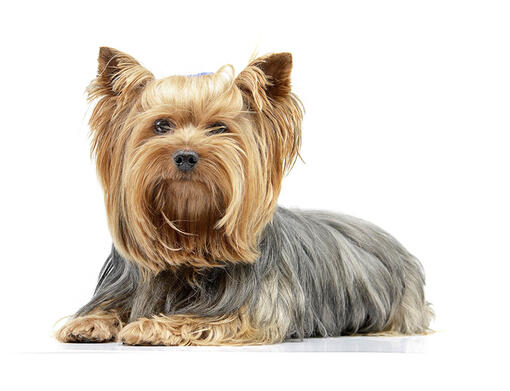
Named for the English city where he originated, the Yorkshire Terrier is brave, determined, energetic and investigative. Originally owned by the middle class, especially weavers, the Yorkie has a long, luxurious blue-and-tan coat. The breed adapts well and travels easily. A protective companion, the Yorkie requires little exercise but needs daily interaction with his family and regular brushing.
DID YOU KNOW? The Yorkshire Terrier is one of the most popular breeds in the U.S.
The need-to-know
- Dog suitable for non-experienced owners
- Basic training required
- Enjoys active walks
- Enjoys walking an hour a day
- Little toy dog
- Minimum drool
- Requires grooming every other day
- Hypoallergenic breed
- Very vocal dog
- Guard dog. Barks and alerts
- May require training to live with other pets
- May require training to live with kids
Personality

The Yorkshire Terrier is a small dog with a big attitude. This is a dog that will one minute happily snuggle on grandma's knee and enjoy a good cuddle, and the next minute leap through the air and tear after the neighbour's dog promising to show it who is boss. Yorkies are terriers after all, and will protect their territory valiantly.
This is a huge dog in a small body! He is lively and curious and into everything – and owners will have to get used to being tailed everywhere by their inquisitive (and often noisy) shadow. This is a dog who needs lots of exercise and stimulation – he loves long walks but also needs games in the house to keep his busy mind occupied.
History and Origins

Country of Origin: Germany
Known as the Grey Ghost, the Weimaraner’s origins spring form the court of the Grand Duke Karl August of Weimar sometime around 1810. His aim was to breed a perfect hunting dog and so crossed German Pointers, French Hounds and Bloodhounds to produce a dog that would be as happy hunting bears as they would be birds. He also wanted a head-turning dog that would be a status symbol for the nobility.
The breed was closely guarded in Germany, until just before the outbreak of the second world war, when a breeder managed to acquire a male and two females and take them to the US. In 1943, the AKC recognised the breed but it wasn’t until the 1950s that they made their way to the UK.
Nutrition and Feeding

Toy dogs have a fast metabolism, meaning they burn energy at a high rate, although their small stomachs mean that they must eat little and often. Small-breed foods are specifically designed with appropriate levels of key nutrients and smaller kibble sizes to suit smaller mouths. This also encourages chewing and improves digestion.
Exercise

To keep your Yorkie healthy and fit, daily exercise is a must. Yorkshire Terriers love walking and will trot on for miles if allowed. A short walk will please a Yorkie so long as he gets a good sniff around and some mental stimulation. Do remember that Yorkshire Terriers aren't just lap dogs, though, and do like to run, fetch and play like any dog. A minimum of half an hour of exercise is needed by an adult daily.
Ideal Owner

The Yorkshire Terrier will suit an owner who wants a big personality in a small package, who doesn’t mind a bit of noise and who enjoys grooming. This is another breed who doesn’t like to be left, and so a home-loving owner is needed.
Other Information

Health and common issues
Yorkshire Terrier dogs tend to have a long lifespan. Nevertheless, they are predisposed to eye problems, kneecaps that may temporarily slip out of place, a specific thigh bone disease, bladder stones, a windpipe disorder and congenital liver disease.
Space requirements
The Yorkshire Terrier enjoys being a country dog but is equally happy in a flat as long as he has access to the outdoors for exercise and toileting. Close neighbours may not enjoy the sound of his voice, however!
Training yorkshire terriers
Yorkshire Terriers are surprisingly clever and can be taught basic exercises easily - although can often be selectively obedient if he is distracted by something exciting! They should be taught to walk on a collar and lead and early and ongoing socialisation in a class with other small dog puppies is vital to prevent them being nervous around other dogs. If they are to live with cats, it is best to find a breeder who rears the puppies with cats and that they are introduced early. He may never get on with strange cats, however.
Best family Dog Breeds
Yorkshire Terriers are not great family dogs as they are too small and delicate for exciting games and some have a traditional terrier short fuse! They can live with older sensible children, however. While many dogs are traditionally thought of as being good with children, all dogs and children need to be taught to get on with and respect each other, and be safe together. Even so, dogs and young children should never be left alone together and adults should supervise all interactions between them.
Did you know?
- The Yorkshire Terrier was bred to hunt and kill rats in the coal mines – and so be small enough to fit in a miner’s pocket!
- While the Chihuahua is recognised as the world’s smallest breed, the world’s smallest ever dog was a Yorkshire Terrier who was only 6cm high.
- One brave Yorkshire Terrier called Smoky was an American Air Force mascot who flew on 12 combat missions and was awarded eight battle stars. She went on to become the first Therapy Dog on record visiting wounded airmen and soldiers in hospital.